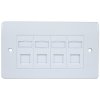New (and inexperienced) user here, looking for some advice.
I have purchased a Lorex IP Ultra HD camera system and NVR for home installation. I took the chance whilst having an extension built to route the Lorex supplied cabling through the walls/floors of my house. However, to do this I had to cut the plug off one end of each cable. The plan is to terminate the four cables in sockets, then patch each to the NVR. I am unsure, however, whether the cabling is constructed to T-568A or T-568B standards. Anyone know?
I am aware that many Lorex systems use bespoke colour coding standards. Yet, it seems that these recently supplied Lorex cables have 8 cores and use standard IP cable colours in twisted pairs. So I am assuming they will be wired either to T-568A or T-568B.
Before you ask… I did call Lorex technical support, but they quickly washed their hands of me when they discovered I had cut their precious cables! No response there. Also, I stupidly threw away the plugs I cut off some time ago, so cannot split open a plug to find out the wiring standard.
I have purchased a Lorex IP Ultra HD camera system and NVR for home installation. I took the chance whilst having an extension built to route the Lorex supplied cabling through the walls/floors of my house. However, to do this I had to cut the plug off one end of each cable. The plan is to terminate the four cables in sockets, then patch each to the NVR. I am unsure, however, whether the cabling is constructed to T-568A or T-568B standards. Anyone know?
I am aware that many Lorex systems use bespoke colour coding standards. Yet, it seems that these recently supplied Lorex cables have 8 cores and use standard IP cable colours in twisted pairs. So I am assuming they will be wired either to T-568A or T-568B.
Before you ask… I did call Lorex technical support, but they quickly washed their hands of me when they discovered I had cut their precious cables! No response there. Also, I stupidly threw away the plugs I cut off some time ago, so cannot split open a plug to find out the wiring standard.





